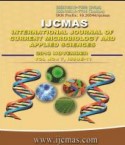


 National Academy of Agricultural Sciences (NAAS)
National Academy of Agricultural Sciences (NAAS)

|
PRINT ISSN : 2319-7692
Online ISSN : 2319-7706 Issues : 12 per year Publisher : Excellent Publishers Email : editorijcmas@gmail.com / submit@ijcmas.com Editor-in-chief: Dr.M.Prakash Index Copernicus ICV 2018: 95.39 NAAS RATING 2020: 5.38 |
During 2015-16 survey was conducted in six different soybean growing areas of Manipur, India. The survey revealed that the maximum mean pod blight intensity was at Thoubal (21.23%) and minimum (13.82%) at Andro Research Farm, CAU. Fusarium oxysporum was isolated and identified by morphological characteristics and gene sequencing, MF-512000. The pathogen was found to be the causal organism of pod blight of soybean. Total genomic DNA of the fungal cultures was extracted by using HiPurA DNA isolation Kit (HiMedia, India). PCR amplification of internal transcribed spacer regions was done using specific ITS1 and ITS4 primers and was confirmed by 1.2% agarose gel electrophoresis which produced a fixed region length of approximately 600bp for Fusarium oxysporum. Effects of volatile compounds produced by the Trichoderma spp. against Fusarium oxysporum ranged from 26.27-42.40 per cent. The effects of non-volatile compounds produced by Trichoderma spp. ranged from 20.39-43.52 per cent at 7.5% v/v concentration and 29.41-53.72 per cent at 15% v/v. In vivo study of isolates of Trichoderma spp. under field trials as seed treatment (@ 5g/kg seed) with foliar spraying (@ 5g/l of water) at 40 days after planting of water showed considerable reduction in disease incidence and increased production over control plot. The isolate T. harzianum (KU933468) showed highest yield in field trial (17.44 q/ha).
 |
 |
 |
 |
 |